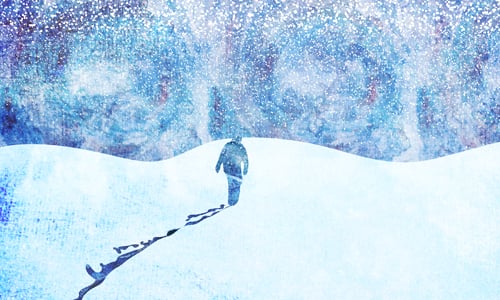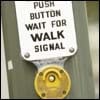What You Need to Know About Snow on Shabbat
If you live in a cold climate like I do, there comes a point in the winter when you barely notice the snow. You walk in it, you shovel it, and you salt it when necessary without giving it much thought. But on Shabbat, there are special rules and considerations to be aware of. Here’s what you need to know.
Is It OK to Touch Snow?
As a general rule, any item that is unfit to be used on Shabbat should not be handled. This classification is known as muktzeh, “cast aside.”
According to most halachic authorities, clean snow is not considered muktzeh1 because you could use the melted snow to, say, wash your hands or water your animals.
However, Rabbi Moshe Feinstein2 and others argue that since we don’t commonly use snow today, it’s considered muktzeh.
Of course, if the snow is so dirty that it’ll be useless once melted, everyone agrees that it’s muktzeh and can’t be handled.3
Read: What Is Muktzeh?
Can I Walk on Snow on Shabbat?
When you walk on snow, you normally crush it. And when you crush snow, you may melt it. So can you melt snow on Shabbat?
Well, you can’t crush snow in order to get water, just like you can’t squeeze a fruit to produce juice.
However, you can put snow (or an ice cube for that matter) into a drink or bowl of soup to cool it down, even though it’ll melt and produce water.4 Why? Some authorities say this is OK because you did nothing to make it happen.
But there is a stricter opinion that if the melted snow becomes distinct (such as if it is not placed into a cup filled with drink), it may be forbidden, even after the fact.
The halachah follows the first opinion (that it can be melted even if it will become a distinct liquid), but it’s customary to follow the stricter approach and only melt snow directly into another liquid.5
Now, this is all about simply allowing the snow to melt on its own.
But crushing snow to make it melt is an issue. However, there is no problem with crushing snow if you’re not trying to produce water,6 so you can break off a piece of snow, or walk on it without worrying about the water that may form in your footprints.
Some say this is the case even if your shoes are wet and you can be certain that some snow will melt. Why? Because avoiding walking where snow might melt is completely impractical. However, some say that if you can easily avoid situations where you know you’ll be causing snow to melt, you should do so.7
What About Clearing Snow?
Though clean snow isn't usually muktzeh, shoveling on Shabbat is tricky due to potential issues with carrying in public domains and the strenuous nature of the task. Let’s dig in!
Carrying in the Public Domain
On Shabbat, we can’t “carry” things between public and private domains (defined as a space surrounded by an eruv), nor can we carry things for more than four cubits (approximately six feet) within a public domain.
So shoveling the sidewalk, or even your front driveway, may be forbidden, since these unenclosed spaces are often considered to be a karmelit, which is treated similarly to public space from a halachic standpoint.
Read: Why Don’t We Carry Outside an Eruv?
Hard Work
Another potential issue with shoveling snow on Shabbat is that it’s hard work, and the Mishnah8 prohibits moving large objects on Shabbat because of the exertion. However, exertion is permissible on Shabbat if it will facilitate a mitzvah. Based on this, many teach that shoveling would be permitted if it would allow people to get to synagogue (provided that there are no issues with carrying).9
Digging
But there is another thing to consider. It’s forbidden to dig on Shabbat or create or smoothen out ridges in the dirt.
Hard snow: According to many authorities, including the Shulchan Aruch Harav,10 if the snow has hardened and become attached to the ground, it’s considered part of the ground. Removing it would be similar to digging something out of the ground, which is prohibited on Shabbat.
Some say that this would be overridden in extremely dangerous situations.11 But even then, it would be ideal to ask a non-Jew to do this for you,
Soft snow: If the snow is soft, you would be allowed to remove it, provided it is on a hard surface like a sidewalk or driveway. However, shoveling on mud would be problematic because you may end up smoothening out the dirt, which is forbidden.12
Salting
If there’s no question of carrying, you can sprinkle salt on areas where you can reasonably expect people to walk in order to prevent slipping. But you should wait until after Shabbat before salting little-used walkways.13
In all of the above scenarios, you can have this work done by a non-Jew—even many of the things you may not ordinarily do yourself (such as shoveling the snow in a karmelit) .14 And even when you may do things yourself, it would be best to ask a non-Jew in order to avoid potential pitfalls.
Can We Play in the Snow or Make Snowballs?
As previously mentioned, if your snow play involves carrying the snow outside of an eruv, it’s a no-go. Also, if the snow is muktzeh (such as filthy snow), playing would obviously be an issue.
But how about playing with clean snow in an enclosed yard? Is that an issue?
We’ve already discussed that mashing or pressing the snow can be an issue if it produces water.15 Many are not concerned about that, especially in this case where the amount of water produced is negligible.16
Building a snow fort or snowman constitutes boneh, “building,” which is forbidden on Shabbat.17 Some extend this to snowballs as well, 18 while others are lenient, arguing that boneh is mostly limited to more permanent structures.19
In practice, most authorities are strict and would not allow the forming of snowballs on Shabbat.20 Some are lenient for kids below the age of nine, but most are not.21
One clever way to avoid the issues is to build your snowballs and forts before Shabbat, which would make them acceptable for Shabbat play, provided that there is no issue of carrying outside of an eruv.22
Can I Brush Snow off My Clothes?
You’ve come home from a snowy walk to synagogue. Can you brush off the snow from your hat and coat? Vigorously or strenuously shaking snow off a garment can potentially be an issue of melaben, “laundering,” which is prohibited on Shabbat.
Instead, gently shake the snow off.23 If the snow has already melted into the garment or hat, then just let it dry out.







My grandfather was Orthodox, and you couldn't get more observant than him. When Bubbe had pain (appendix burst), he called the ambulance and shoveled snow on Shabbat. He wanted to make it faster for the ambulance attendants to carry her to the ambulance. He helped them carry her, because she was a large woman. Then he drove to the hospital. He said, HaShem knows.
A burst appendix (or even an inflamed appendix that has not yet burst) is a matter of life and death requiring emergency surgery to prevent death, so none of the regular Shabbos prohibitions apply, and it is not only permissible, but required to do whatever is necessary to preserve life (with the exceptions of murder, idolatry, and some sexual things that aren’t relevant to this situation).